What is dynamic books? Why should B2B sales teams care?
Dynamic books is an approach to sales territory management that uses data and automation to create dynamic account books based on account potential fit, in-market timing, and a sales rep's available capacity.
A dynamic books model adapts to changing market conditions better than a traditional territory model, uncovers missed opportunities in your CRM, helps reps work more effectivity, and leads to increases in pipeline. Let's talk about how it works.
What's wrong with traditional sales territories?
Traditional static sales territories make account coverage harder. Why? Static territories lead to:
-
Unequal opportunity: Some reps can’t work all their good accounts, while others fight for scraps in weaker territories
-
Prioritization problems: Pushes the burden fully onto reps, wasting time and reducing the value of data investments
-
Execution drag: Static “patches” aren’t responsive to market conditions; many sales plays and experiments aren’t possible
-
Coverage black holes: The cumulative impact is misallocated sales quota capacity causing gaps in market coverage and missed revenue
Instead of territories, dynamic books uses account-based books that are constantly refreshed, with accounts moved in and out as they demonstrate intent or go cold.
How does dynamic books work?
In a dynamic books model, accounts are dynamically distributed to reps, ensuring the highest potential accounts are always being worked, and rep books stay balanced.
Reps are responsible for actively working every account in their book, and only own accounts they are currently working on. This approach is flexible and automated, eliminates the need for annual territory planning, and ensures that every rep has quota coverage while maintaining balanced books.
Account coverage requires continuous adjustment. And coverage must be actively managed all the time; it’s not a once-a-year process. Dynamic books ensures that sales teams:-
Identify “black holes” in your market coverage. What accounts are you missing out on? Find them and distribute them to reps who can work them right now.
-
Inject flexibility in account assignment. To ensure adequate coverage, you will likely need to retrieve accounts reps can't or shouldn't work right now, give them more and better accounts to work, and otherwise adjust the accounts in their books.
-
Integrate rep-level account coverage into every 1:1. Help reps learn how to better cover the best accounts in their books or territories to improve individual rep productivity.
Why does this matter? Because not all prospects in your TAM are created equal. Some aren’t a good fit. Others don’t have the right timing. You need to focus on the highest potential accounts that have both the right ICP fit and are in-market for your solution. A statically carved-up territory segment can't provide the right mix of high fit, high timing accounts for every single rep. Particularly now, when every single account matters.

Why now?
100 years ago, geography was the best we could do to divvy up accounts for sales reps to work. But a lot has changed in the past 100 years. And for B2B sales teams, even more has changed in the past 3-5 years. Some of those changes include:
-
Reliable and pervasive video conferencing
-
Remote, flexible work
-
Less in-person selling, fewer field sales reps
-
More and better data on companies, prospects, contacts
-
Better sales engagement and CRM technology
-
Difficult economic conditions
We simply don't need geography any more. The dynamic books model addresses a lot of the challenges brought on by static geographic territories, such as attainment imbalances, missed opportunities, and painful planning.
What do reps think?
Sales reps have to deal with a lot of change - they're always dealing with new products to sell, updates to their commissions and sales quotas, new team structure, and so much more. But just because they're used to change, it doesn't mean they love change. So naturally, sellers can be a little apprehensive before a dynamic books roll-out. However, we've found that reps pretty quickly see the results of this change, and it doesn't take long for them to love it.
We recently held our first-ever dynamic books summit and heard from a range of companies that had moved to a dynamic books approach. At that summit, Emilia Meldrum-Taylor, CRO at Quantive, said,
"I was talking to an AE who said, 'You cannot take dynamic books away… Dynamic books is the best thing that I've seen in sales. It gives me focus.' It's music to my ears to hear this from our reps."
Interested in learning more about dynamic books? Start by getting our intro guide to dynamic book management or schedule a demo of Gradient Works.




